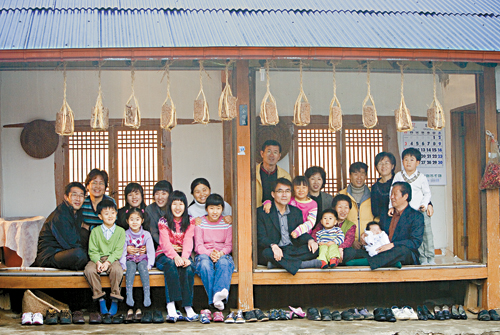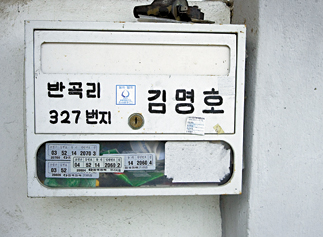A place where every pan tells a story

Kim Myung-ho (foreground, far right) with his family, including the new grandchild in his lap, in the house where he has lived for 70 years.
Ms. Kang felt frustrated that her daughter did not understand the importance of the objects. “Your grandmother gave that saucepan to me 20 years ago,” she said. “And that cup was from your uncle, who bought it with his first paycheck.”
In every corner of the house there are objects with stories attached, and, all together, they tell the history of Ms. Kang, 69, and her husband, Kim Myung-ho, 71. They have spent their lives in Bangok-ri, Geumnam-myeon, Yeonki county, South Chungcheong province. Mr. Kim was born here and expects to be buried in his native soil.
“Dad, come in. It is cold,” said his daughter. She had stopped fussing over old pans and was now working on lunch. “Sister, unfold three tables. Did you pour out some radish kimchi soup?”
During the Lunar New Year holidays Mr. Kim’s house, located at the entrance to Bangok-ri, was crowded. His children and grandchildren all came. “Come more often.You live close by,” said Mr. Kim’s wife, 69, wearing a gentle expression. She was speaking to two daughters and two daughters-in-law who were bustling around the kitchen. She was holding her youngest grandson in her arms like he was some sort of treasure.
This Lunar New Year holiday was special to Mr. Kim and his family. In 12 months time they may be greeting the holiday in a strange place. Bangok-ri has been chosen as the site where the country’s new administrative capital will be built.
“This has been my house all my life. My neighbors have been here a long time too. I don’t know what to do,” he said. Mr. Kim smiled but his sense of regret was obvious.
Mr. Kim’s grandfather remodeled the house in 1937. In the 1960s a new roof was added. The well was repaired in the 1970s and a modern kitchen was installed in the 1990s. A modern bathroom was built inside the house in 2003. Mr. Kim was born in the house and spent a hungry childhood there. Later he met his wife in its living room. They have two sons, two daughters and 10 grandchildren. Everything in the house, from pillars to door frames, has been touched by them a million times. There isn’t a single spot in the house that doesn’t have a happy memory
Mr Kim thought it would be very sad for all the history in his house to vanish, and some professionals at the National Folk Museum agreed with him. Their goal was to select a house in the village that was likely to be demolished and investigate all the things it contained. They chose Mr Kim’s house.
The investigation began in October 2005 and continued for four months. The investigators recorded every detail, including broken pieces of porcelain found in the stable. They documented a total of 5,000 objects that had been used in the house.
“There is an invisible string in the objects that ties together Mr. Kim and his wife, their children and relatives,” wrote museum curator Kim Ho-geol in a report on the project. “In its center, Mr. Kim maintained a kind presence who insisted on excellence. Even a plastic bag can tell a long story. A plastic bottle bore the children’s devotion to their parents and the parents’ love of their children. All these items captured my heart.”
The thick report on the house was published earlier this month and is a heartfelt gift to Mr. Kim and his family. The report contains information on items like ear picks and a pair of traditional overshoes along with their pictures. “Look at the report. I felt a deep emotion that I can’t describe when I first saw it,” said Kim Young-ok, 43, the second daughter.
“My parents are very warmhearted people,” she said. “We were poor, but we always had laughter. They weren’t greedy and had good manners. They worked day and night but never borrowed money. They always said, ‘what do you need? We are all good people, we can help each other.’ Their whole life is contained in the book. Thank you father and mother.”
Mr. Kim and Ms. Kang have lived an ordinary life together as farmers. They have never looked for or received attention from the world.
Mr. Kim was 19 when he married Ms. Kang, who was then an 18-year-old girl living in a nearby village. Their parents were poor, but both sides offered presents to the other’s family. “When I got married, I wore a new cotton jacket and a new pair of silk pants,” he said. “I still have them. It is said that wearing these clothes in one’s coffin illuminates the way to the afterlife.”
The young groom, however, joined the army four months after their marriage. His kindhearted bride had to endure a harsh life, alone in her husband’s house with her mother-in-law, who was very strict.
Ms. Kang worked in a clothing factory for eight years before she married.
“My father told me that I couldn’t go to school, it was my older brother who should be given an education. So my brother went to school instead of me. I cried so much,” she said. Two years after she married, Ms. Kang’s mother-in-law bought a sewing machine with money she earned by selling two large bags of rice. Ms. Kang was then obliged to spend many sleepless nights alone, in front of the sewing machine.
Mr. Kim returned home, but the couple’s worries did not go away because Ms. Kang did not get pregnant. “My mother-in-law was hard on me because I didn’t have a baby,” said Ms. Kang. “When I heard my neighbor had given birth to a baby, I felt like my body was shrinking with shame. I felt there was no hope.”
Six years passed before there was a baby, the first daughter, Young-ja who is now 45. The second daughter, Young-ok, 43 soon followed. Then the first son, Young-cheol, 41, and the youngest Cheol-min, 37.
The stainless steel tray standing in a corner of the kitchen reminds Mr. Kim of the past. “It has a history. My first son accidentally fractured his leg when he was in the third year of elementary school. The treatment went wrong and the bone had to be broken again. He then had to wear a plaster cast. He stayed in the hospital in Daejeon for two months. My mother and I were tending my son, and my wife sold side dishes in the market to make a little bit of money. We got the tray at that time.”

Young-ja has always been the model of an eldest daughter. She worked and studied at the same time. At 24, she met her husband, Yun Yong-su, a civil servant. Mr. Kim and his wife said their first son-in-law is “a decent man,” who always prepares bottles of makgeolri (rice wine) for holidays.
“Our first son-in-law likes to drink. He also likes to give things to other people, and when he was working in a district office, he always delivered a bottle of makgeolri. I still ask whether he needs another bottle,” Ms. Kang said.
The second daughter was smart and had integrity. They were as proud of her but also worried about her. “After she graduated from high school, she wanted to go to college. It was a tough time in the economy and I said to her, ‘There is a work I have considered for you. You can work there.’ But she didn’t want to do that, no matter what. She had to pay her tuition by 11 a.m. that morning. If we didn’t pay the tuition, I thought we would ruin her life. There was no way. We had to borrow the money,” Ms. Kang said.
Young-ok, the second daughter, began working. Her parents wanted her to get married before it was too late, but her daughter was stubborn. “I was in agony because she didn’t get married until she was 36 years old,” Ms. Kang said. Young-ok is now married with two children, and is dedicated to her parents. Ms. Kang said her first daughter-in-law, Seo Young-ran, was very bright. “She is good with housework. In the beginning, I thought she was a little too big for a woman, but after some time passed, I realized she was the best daughter-in-law one could have,” she said.
The second son, Cheol-min, and his wife, Shim Mi-ae, are equally good, she said. “Cheol-min graduated from high school and worked in a factory in Suwon. He had a hard time there. One day, he said he was going to get married and gave his father 6 million won. He thought his father needed the money for his wedding. My husband replied, ‘I have money for your wedding,’ but Cheol-min would not take the money back. All our children married without asking for any money from us,” Ms. Kang said. The first son now has two daughters and one son, and the second one has one daughter and two sons.
Mr. Kim’s children all live in Daejeon, and they always gather at their parents’ house at least once a month. “My children always buy us things. We don’t need to buy clothes or medicine,” Mr. Kim said.
In return, Mr. Kim and Ms. Kang give their children rice and vegetables as well as soy sauce and gochujang (hot bean paste), which Ms. Kang makes. They also provide tteok (rice cakes), makgeolri, dried herbs and sesame seed oil whenever their children ask for supplies.
“When we leave this place, what worries me most is that we will not be able to give them these things anymore,” said Ms. Kang.
By Lee Na-ri JoongAng Ilbo [jbiz91@joongang.co.kr]










with the Korea JoongAng Daily
To write comments, please log in to one of the accounts.
Standards Board Policy (0/250자)